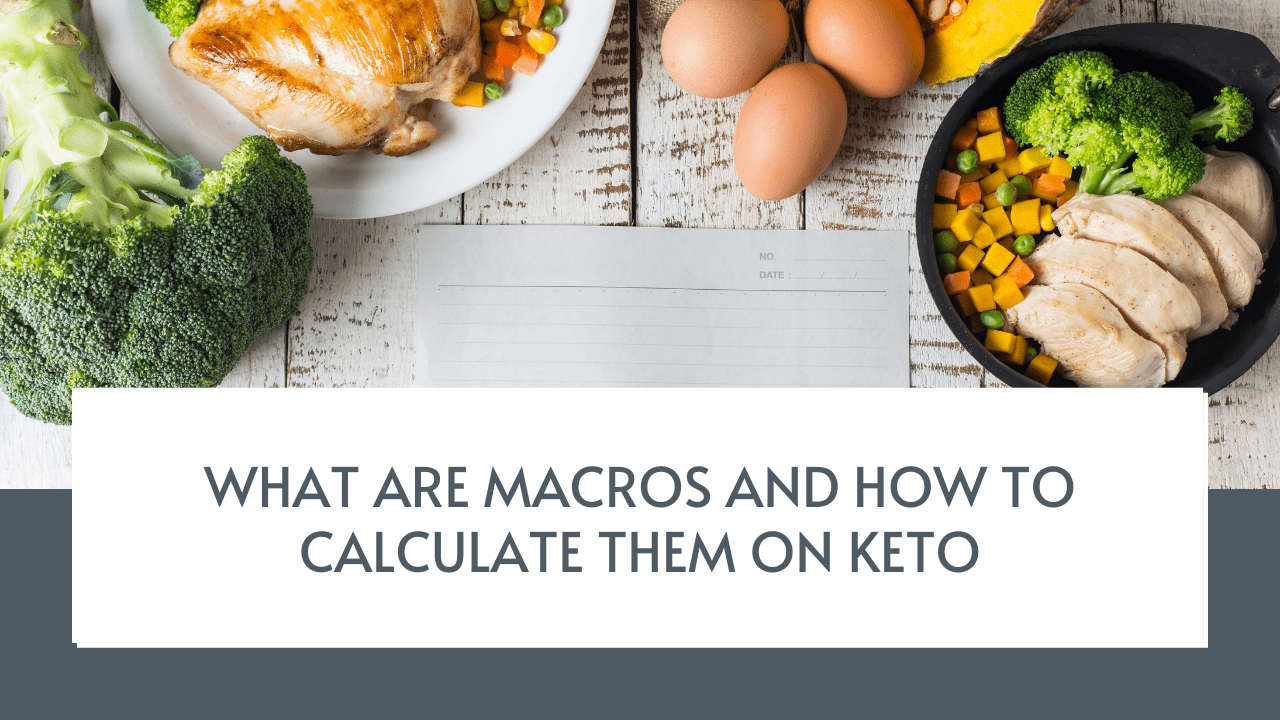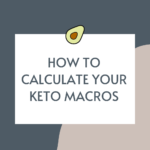What are macros? Why are they important, and How do you calculate your keto macros?
I’ll answer these questions and share everything you need to know about macros in this post.

Whether you are new to Keto diet or have been following the diet for some time, you have probably heard the term “macros.”
So, precisely what are macros, and what do they have to do with the Keto diet, or any diet for that matter? How do you calculate the right macros for your body and goals?
What are Macros?
Macros are short for Macronutrients.
There are 3; Carbohydrates, Protein, and Fat.
They are what determine the calorie content in the foods you eat.
Carbohydrates: 1 gram= 4 calories
Protein: 1 gram= 4 calories
Fat: 1 gram= 9 calories
Why are Macros Important for Keto?
Determining your specific macros helps you achieve your weight loss and fitness goals when it comes to standard Keto diet.
Now, I am not saying that you can’t get into ketosis without calculating your macros and tracking them because you can. I do it all the time, and I teach my clients inside my program to lose weight without obsessing over macros.
The Keto diet is about keeping carbs low enough to get into Nutritional Ketosis and not about macros.
However, knowing your macros allows you to achieve specific goals, such as losing a particular amount of weight in a particular time frame, building muscle mass, or reaching a certain body fat percentage.
Figuring out your specific macros for keto helps you know correctly what to eat daily and how much of a particular macronutrient to consume.
Tracking your macros when you are new to Keto diet is essential because it ensures you are doing the diet correctly, enables you to learn about the macros in different foods, and makes weight loss easier.
What are the macro ratios for Keto?
There are different macros you can follow for Keto diet depending on your exact goals, but here are the “standard” ketogenic macro ratios.
Note: Your macro ratio should be customized to you based on how much fat you have on your body, whether you have a gallbladder or not, and how much you work out.
If you want to learn how to customize your macros, I can help you with this inside my program.
- 60-75% of calories from fat
- 15-30% of calories from protein
- 5-10% of calories from carbs
These percentages are average, but carbs are the main focus of the Ketogenic diet.
To reach Ketosis, you have to keep carbs at 5-10% of your daily calorie intake.
How do you calculate your personal macros?
Step #1: Calculate Your Basal Metabolic Rate (BMR)
The easiest way to do this is to use the Harris-Benedict equation. This is giving me flashbacks to when I was in Dietetics school (I hated doing this calculation)
For men:
- 66 + (6.2 x Your current weight in pounds) + (12.7 x Height in inches) – (6.76 x Age)
For women:
- BMR for women = 655.1 + (4.35 x Weight in pounds) + (4.7 x Height in inches) – (4.7 x Age)
So for me, it would be 655.1+ (4.35X145)+ (4.7×64)- 4.7x 33)
Ah, I hate math.
655.1+623.5+300.8-155.1=
So the number is 1,424.3 calories.
But we are not done.
Now we have to calculate my daily energy expenditure, meaning how many calories I burn each day.
You can find this out by multiplying your BMR by these numbers (choose the number associated with your level of daily physical activity):
- 1.2: Little to no exercise
- 1.375: Light exercise 1–3 days per week
- 1.55: Moderate exercise 3–5 days per week
- 1.725: Hard exercise 6–7 days per week
- 1.9: Very intense exercise
Now, be honest with yourself. If you are a couch potato, now is not the time to pretend you do “light exercise.” You will only be hurting your results in the long run.
Remember, you can always adjust this number later, so it’s not set in stone.
Ok, so on average, I do cardio for 40-60 min 5x a week and lift five times a week, so I am going to be conservative and say moderate exercise. I could get away with saying hard or intense since I am currently training for a half-marathon, but you always want to go below what you are so you can have a more significant deficit= more weight loss.
So we take 1,424.3 x 1.55= 2,207
So based on this manual calculation, I need to eat 2,207 calories each day for my body type and physical activity state to maintain my weight.
If I wanted to lose weight, I would need to have a deficit and lower the number. I will reduce that number to 1600 cal. That is average for me.
Ok, so now we have our calorie number, we can plug it into the standard Keto macro percentages and find out exactly how many calories of each macronutrient I need to eat.
Remember the Keto macros?
- 60-75% of calories from fat
- 15-30% of calories from protein
- 5-10% of calories are from carbs.
So that is 960- 1,200 calories from fat
240-480 calories from protein
80-160 calories from carbs
How do you track your macros for Keto?
Download a tracking app
Now that you know your exact numbers, you can download My Fitness Pal, Cronometer, Lose It, or any other food-tracking app. I use My Fitness Pal and have been using it for years. It has the largest directory of food, and it’s so easy to use.
Get a food scale
To ensure you are eating the right amount of food, you will have to measure it. The best way to do this is to get a food scale. I use this OXO scale and love it. I’ve had it for years, and it works just as well as the day I bought it.
Get a free Clean Keto Food List
I created a free Clean Keto Food List, which lists all the foods you can eat while following a Clean Keto Lifestyle. This is very helpful when you are planning what you are going to eat to make sure it fits in with your daily macros.
Do you have to track your macros on Keto?
NO. Absolutely not. I don’t really track anymore, and here are the reasons:
Cons of tracking macros on Keto
It’s annoying.
I don’t want to spend my life measuring my food and plugging everything I eat into my fitness pal. It takes a lot of time and work, and to be honest, I have done Ketogenic diet long enough to know what and how much I should be eating.
If you are like me and the thought of tracking your macros turns you off, but you want guidance on what to eat and how much to eat to get into Ketosis, you should get my Clean Keto Meal Plans. I do all the work for you and calculate all of the macros.
You don’t need to think of anything. All you do is make the recipes. I include the menus, weekly shopping lists, and all the recipes for you. It’s super convenient and works well for weight loss and getting all the benefits of the Ketogenic Diet.
It can become very stressful
I see this happening all the time. People message me and ask me on Instagram often about why they can’t hit a specific macro or freak out because they went over 5 grams of protein.
Who cares?
Honestly, it’s not going to affect your results.
I also see a lot of people struggle to get their “fats” in, and that, again, is NOT the purpose of Keto.
Ketogenic diet is about keeping carbs low, not fats, at a certain number. Fat should be used as a tool to keep you full, not a specific amount that you need to hit each day.
This may lead to poor food quality choices
You may have heard the acronym ITFYM (If it fits your macros).
While I don’t have anything against people who eat this way, it can be a slippery slope when it comes to food quality.
Eating this way means you can eat Keto junk food, processed food, high-inflammatory foods (such as dairy), and low-quality meats and cheeses as long as they fit your “macros.”
I don’t condone this way of eating because eating this way always causes me to weigh lose stall and gain weight on Ketogenic diet. That is why I prefer to eat Clean Keto for the most part. Check out if Clean Keto Carb Cycling is right for you!
In conclusion, when it comes to tracking your macros, you have to do what is best for your body and your lifestyle. It’s just like with anything else in life. DO YOU BOO!!
If you know you are the type of person that gets super stressed about things, if you don’t “hit” a specific goal, then don’t track. Worry about keeping your carbs below your threshold and focus on eating real, whole foods.
On the other hand, if you are the type of person who needs the accountability of the numbers and tracking, then track away!! It should be helping you and not leading you to stress and anxiety.
Keto is a lifestyle, not a diet. Don’t approach it like a diet, or else you will do the inevitable, cheat and fail.
If you do cheat, here are some great tips to get back into ketosis fast.
Comment below and tell me your thoughts on track!!
More articles about Keto Diet:


2 thoughts on “How To Calculate Your Keto Macros”